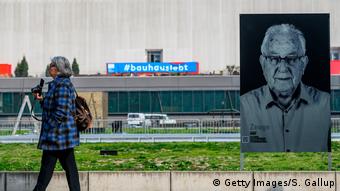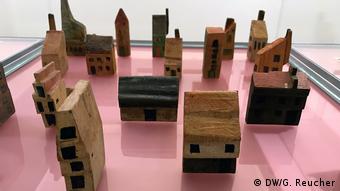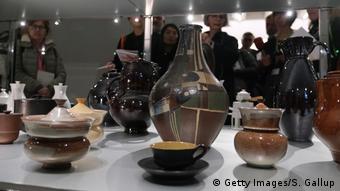The originals of the most famous Design classic are to be seen in the new Museum. The building is controversial, the site also, but the content is convincing. The city wants to put up with this Museum, a conscious break with the past.

How do we want to live in this world? As a people, are in accordance with nature, or as a technically-oriented “machine-man”? We want to keep ourselves physically fit and vegetarian feed, or we leave everything to a higher addition? With these questions, the students at the “Staatliches Bauhaus”, Walter Gropius employees on 6. April 1919 in Weimar as an art and Design school founded.

The cradle by Peter Keler, one of the Central exhibits
Weimar, the “cradle” of the Bauhaus, the modern, experimental ideas, which was followed by the Weimar citizens at the beginning of the 1920s, with suspicion. Finally, the city canvassed, even then, for as Goethe, the city and as the city of Weimar classicism. Long the Bauhaus resulted in the culture of memory a shadow existence, but with the new Bauhaus Museum seeks to change that. The cradle by Peter Keler, one of the most famous objects in the permanent exhibition, adorned with symbolic posters and brochures. How we will live in the future, is the theme that runs through the duration of the exhibition.
Controversial construction with an open space concept
From the Outside dasBauhaus-Museum in Weimar is said – simply – a grey concrete block. A cubic structure with a closed in. “There were campaigns against the architecture, in which the people signs hung with the inscription: ‘Where are the Windows?’”, Wolfgang Holler, General Director of the Weimar museums of the Klassik-Stiftung Weimar told. In fact, the facade has few Windows. The bigger the Surprise is when you take the open space concept Inside true. “This is not a Bunker, but it has the high Ceilings, lightness, and radiates at the same time grandeur,” explains architect Heike Hanada.
The floors are partially open at the top offset from each other. So the top of the three floors are classics with the famous Design, like the cradle of Keler, the table lamp by Wilhelm Wagenfeld or the tubular steel chairs by Ludwig Mies van der Rohe, to the bottom of the view on video screens, on which figures in rigid costumes on the stage to dance. The theatre workshop was the creative centre at the Bauhaus, and dealt with the question of how the human being moves in space. At the same time, the stage was a place for many appearances at the infamous Bauhaus festivals.
The expulsion of the Bauhaus from Weimar

Witnesses of forced labour. In the vicinity of Weimar, the memorial site of the Buchenwald concentration camp is located
But after six years of full-Strength was with such imagination in the Weimar end. The Bauhaus was expelled in 1925 for political reasons, out of the city, and finally in 1933, with the seizure of power by the national socialists finally dissolved. You can’t remember the Bauhaus, to his expulsion, said the Thuringian Minister of education, Benjamin-Immanuel Hoff on the occasion of the opening of the Museum.
Totally aware of the Museum is, therefore, a historically controversial – and in the city is very controversial. On the one hand, the idyllic Park of Ilmenau, on the other hand, the massive construction of the national socialists, the former “Gauforum”.” The Gauforum in Weimar was the place of the forced labour movement was coordinated,” explains Wolfgang Holler. Also for the construction workers were forced to work from the nearby Buchenwald concentration camp. Today, the Bureau of land management is in the former Gauforum. Soon there will be opened an exhibition on forced labour in Weimar.
You have decided exactly for this location, the Modern and the national socialism to be processed, says Holler. It was not, however, communicated to the Public yet strong enough. “Urban development is placed a Monolith very well, because he radiates in this heterogeneous Situation, a certain power,” says Heike Hanada. “He is also a classic attitude in the Modern age, where you defined the architecture as simple as possible.” Around the Bauhaus Museum and the Gauforum, the city wants to create in the future headquarters of the Modern. The reception of Weimar as a city of classical music belong to the past.
The dawn of a new era

A look into the “New Museum” in Weimar, with the interior style of Henry van der Felde (on the left)
Was founded the Bauhaus in a time of upheaval. The first world war had shattered the Empire, the industrialization changed life. Women received the right to vote and went to work. Simple, practical and functional the life-world should be affordable for everyone, which were the goals of the Bauhaus. The Ballast of the Empire seemed to be in the arts and crafts obsolete, a modern, functional Design.
A precursor to such ideas, the school of arts and crafts by Henry van de Velde was already. He designed a simpler Design, through architecture, furniture, and clothes as a kind of total work of art. Thus, man should live well and comfortably. The corset for the women was replaced by a long wide robes. The emancipation of women had begun. All of this can be found in the “New Museum” was opened in close proximity to the Bauhaus Museum. Here is the history of the Bauhaus is the beginning of the 20th century. Century shown at the Walter Gropius.

Experiments in a new architecture, or simple building blocks?
Van der Velde from the style and the beautiful shape, the shapes of the people, Gropius wanted to go the opposite way: “He has said, you have to change the people, then you can change society, and then you find a good style,” explains Museum Director Wolfgang Holler.
The Bauhaus as a field of experimentation
Indeed, the Bauhaus was the beginning of a field of experimentation. “Here, you could develop ideas and also to fail,” says Museum Director Ulrike Bestgen. Sketches and images to show different ideas for new people and new lifestyles.
One floor higher and it is about specific forms of living. The so-called “Frankfurt kitchen”, although not built at the Bauhaus, but it is an example of the first built-in kitchen with many small drawers and compartments, which contents were neatly arranged and easily accessible. The colorful multi-functional wooden boxes in the children’s room of Alma Siedhoff-Buscher to show how they imagined a relief in daily life with practical and functional furniture.

Rosa Luxemburg, as a possible model for the “New woman,” (on the right) advertising for a vegetarian cookbook – from the “woman” something to prepare
That the Bauhaus was not yet emancipated, shows a spell of Bauhaus masters, Muche, who said quite clearly: “the kitchen is The experimental field of women”. Most of the women at the Bauhaus were also more likely to be in the weaving than in the Construction or in the architecture class of employees. As one of the few women Marianne managed to Brandt in the metal workshop. In the last Station of the exhibition, where it comes, what is left from the Bauhaus out of Weimar in the beginning of time, to see their famous teapot and other metal objects.
At the sight creeps up on a certain amount of awe. Because even though all of these things in a cost-effective industrially produced in a series should be, everything is made by hand. The metal work you see in part, even the weld seams.
What remains by Bauhaus
The teapot is part of work, as well as the Wagenfeld lamp, and numerous ceramics, chairs and rugs to a collection of Walter Gropius. “These 168 items in its collection, has left Walter Gropius in the city, when the Bauhaus closed in Weimar,” says Wolfgang Holler. “In the 1930s, they were hidden in the castle in order to evade the access of the national socialists.”

Gropius-collection: objects from the ceramics workshop
“In the course of the Museum, many families are still on us and not letting us have things that we all incorporate were here at all,” said Ulrike Bestgen. Overall, the collection over the years has grown to 13,000 objects, of which 1000 in the new Bauhaus Museum.
You can look forward to in the future on many thematic exhibitions, which will strengthen the culture of remembrance at the Bauhaus in Weimar.